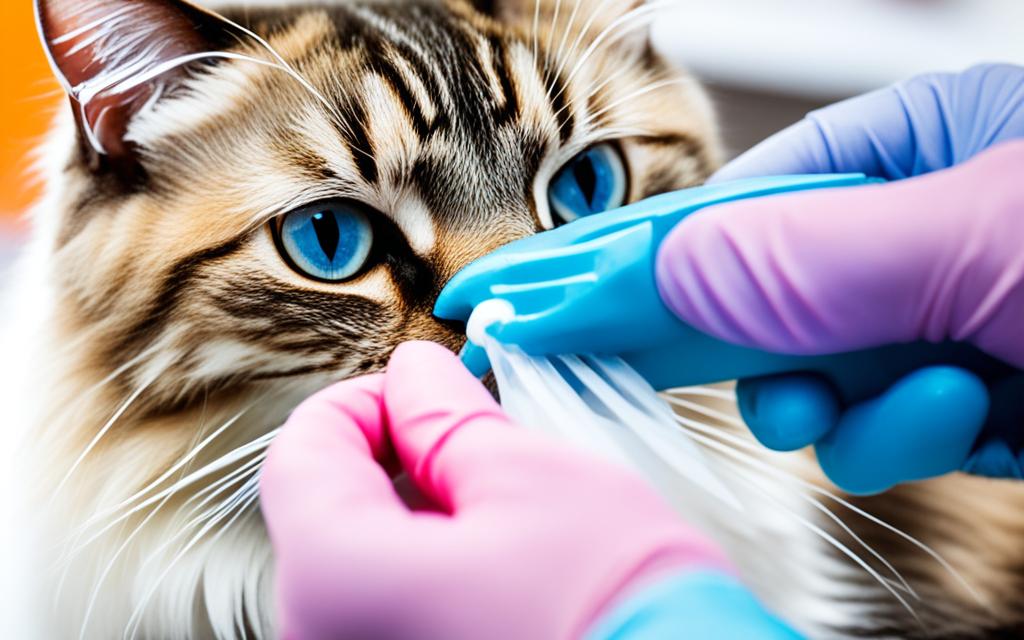How to Get Rid of Fleas on Cats Without Bathing

How to Get Rid of Fleas on Cats Without Bathing – Fighting a flea problem on your cat can often feel like an uphill battle. But, you might not have to dunk your pet in the tub. At Protect My Pet, we aim to help you keep your cat’s coat clean of fleas without bathing stress. We’ll give you top-notch advice on tackling fleas without water, mixing quality flea solutions, home cleanliness, and smart prevention steps.
Fleas are more than just a bother for cats and dogs. They live off blood. Despite being small and wingless, fleas can jump huge distances. For their size, they’re lightning quick. So fast, you might not see them for days. They cause red, itchy bumps when they bite. Some pets get itchier than others because of an allergy to the flea’s spit. If your pet’s scratching a lot, it’s time to look for signs like tiny dark specks in their fur or on their favorite sleeping spots.
Identifying Flea Infestation in Cats
Seeing if your cat has fleas is step one to stop an infestation. Signs might not jump out at you at first. But, there are clear clues your cat might be a home for these bugs. Watch for dark specks in their fur or lots of grooming. Knowing what to check for helps spot and treat fleas fast.
Signs of Fleas on Cats
How can you tell if a cat has fleas? Keep an eye out for dark specks moving in their fur. If they scratch, chew, or bite more than usual, that’s a sign. Look for fur loss or irritated, red skin. Swellings on the body or lips are called eosinophilic plaques. Your cat might get extra clean to ease itchy flea bites. So, if they lick a lot or rub on things more, they could have fleas.
Using a Flea Comb to Detect Fleas
Fleas hide well and are hard to see without help. A fine-toothed flea comb is great for checking your cat. If the comb gets dark specks, it might be fleas or their waste (flea dirt). To be sure, put the specks on a wet tissue. If it leaves a red circle, that means digested blood. That’s a big sign your cat has fleas.
Inspecting for Flea Dirt
Checking your cat and their stuff for flea dirt often can find fleas. Look for tiny, dark specks like ground pepper. When you test these specks on a wet tissue, you’ll see a red ring. This shows digested blood and confirms fleas.
Choosing the Right Flea Treatment for Your Cat
When looking for flea treatments for cats, you have many options. Each option is made to get rid of fleas and prevent them from coming back. But, not every treatment is right for every cat. It’s important to pick the best one for your cat’s health and happiness.
Spot-On Flea Treatments
Protect My Pet suggests spot-on treatments for cats. They are easy to use. Plus, most cats don’t mind them. Flea tablets are also out there, but they can be hard to give to cats.
Here at Protect My Pet, we think spot-on treatments are the best way to go.
Oral Flea Medications
Frontline Plus and Advantage are top brands in the UK. Imidaflea Spot-On Solution and Fleascreen Combo are also good choices. They are effective and affordable.
Considering Safety and Efficacy
Think about the maker, product reviews, and the cost of the flea treatment. These can tell you if it’s a good product. Remember, the most expensive and cheapest may not be the best. Aim for something safe and that does the job for your cat.
Home Remedies and Environmental Control
Effective flea treatments are crucial. But, we can also use home remedies and take control of our environment. These steps make our plan to fight fleas more powerful.
Vacuuming to Remove Flea Eggs and Larvae
Vacuuming is key to getting rid of flea eggs and larvae. Vacuum your carpets, floors, and furniture well. Don’t forget to clean in cracks and crevices. Flea eggs and larvae often hide there. Do this every other day for 3 weeks.
Afterwards, make sure to clean your vacuum. Flea eggs can survive in its bag or canister.
Using an Insecticidal Home Flea Spray
Vacuuming is not always enough. Using a quality insecticidal flea spray like Indorex is also important.
Follow the spray’s instructions. Cover every room, including where your pet sleeps. This kills adult fleas and stops eggs and larvae from growing.
Remember, washing and vacuuming are good steps. But, to get rid of all fleas, an insecticidal spray is necessary too.
how to get rid of fleas on cats without bathing
After using a flea treatment, avoid bathing your cat. This action could weaken the treatment. Also, it pollutes water with insecticides. Using flea shampoos isn’t a good idea. What’s great is that a bath isn’t always necessary for your cat’s health. If you think your cat might not like it, you can hold off on this.
Too much bathing is a problem too. The right bathing frequency varies. Your vet can help decide what’s best for your cat. For some, daily baths might be necessary to control an infestation. Others might only need a bath once a week. The type of shampoo matters too.
Preventing Future Flea Infestations
To keep your cat, home, and family free from fleas forever, treat your pets often. Quality flea treatments each month for your cat will stop fleas from coming back. These treatments kill fleas when they touch your cat, ending their life cycle. This keeps your home safe from infestations.
Regular Monthly Flea Treatments
When cats get flea treatments every month, they’re less likely to get fleas again. These treatments stop fleas from laying eggs and spreading. Make sure to pick a flea product that vets recommend for the best results.
Flea Prevention for Indoor Cats
Some think indoor cats are safe from fleas, but this isn’t true. Fleas can come from the garden or from meeting other animals. So, it’s vital to give indoor cats monthly flea treatments. This protects them and your home from fleas.

Risks and Complications of Flea Infestations
Fleas bother more than cats. They can be really harmful to health if not dealt with. They don’t often kill, unless they’re on very young kittens in big numbers. But they can lower a cat’s happiness and comfort. Flea issues can lead to allergies, itchy skin, spreading tapeworms, and even make people sick.
Flea Allergies and Skin Irritation
Some cats might get allergic to fleas after many bites. This can make them really itchy, lose hair, and have big lumps. Fleas’ spit when they bite is what causes this problem.
Tapeworm Transmission
Fleas are not just itchy but they can also bring tapeworms. If a cat eats a flea, it can get tapeworms in their gut. This may cause stomach problems for the cat.
Potential Health Risks for Humans
Fleas that normally live on cats can bite humans too. They may cause itchy red spots, especially in threes. These fleas might also carry Cat Scratch Fever, a sickness that can spread to people through cats’ scratches. Keeping fleas away is key to keeping everyone safe.
Treating Kittens for Fleas
Treating fleas on kittens requires safe, age-appropriate products. Make sure what you choose suits your kitten’s size and age. Also, keep an eye on their weight to adjust the treatment as they grow.
Age-Appropriate Flea Treatments
For kittens under three months, a trip to the vet is best. They need special care that the vet can provide. After three months, signing up with Protect My Pet gets them the right flea treatments without hassle.
Consulting a Veterinarian
Always talk to a vet for flea advice, especially with young ones. Vets can recommend the best flea products and check for health issues. They also help with advice on treating any illness caused by severe flea problems.
Flea Bites on Humans
Cat fleas bite people, but they can’t live on us. You might see red bites that itch, often in threes, on your ankles or wrists if your home has fleas. This is because fleas prefer our pets.
These bites can itch badly, but they don’t usually make us sick. The main worry is catching Cat Scratch Fever from these fleas. Luckily, getting sick this way is not common. You can lower this risk by getting rid of fleas quickly if you find them.
Finding flea bites on you means it’s time to fight the fleas. A good plan includes treating your pets and cleaning your home well. This helps kick the fleas out and stops more bites later on.
When to See a Veterinarian
Fleas usually aren’t an urgent issue. You can often handle them at home. But, the best approach includes using flea medicine like a collar or a treatment.
Signs of Severe Flea Infestation
If your pet is tired, losing weight fast, or scooting on the floor, see a vet. Also, look out for tapeworm signs in their stool or pale gums. Quick action can help your pet’s health and happiness.
Seeking Professional Advice
If you’re worried or the flea issue seems big, talk to your vet. They can offer the right and safe advice for your cat’s health. This is important to make sure severe infestations are handled well.
Conclusion
The best way to fight fleas on cats without bath, combines good treatments, clean surroundings, and prevention. Check your cat often for flea signs. Use a flea comb and apply safe flea meds. This approach will help you get rid of fleas.
Also, remember to vacuum, wash things, and use home flea sprays. This helps stop fleas from coming back. It’s a full strategy to keep your cat happy without frequent baths.
Your aim is to keep fleas away from your cat with smart and safe actions. With attention and the right steps, your cat can enjoy a flea-free life. This will keep them from being uncomfortable or getting ill because of fleas.





